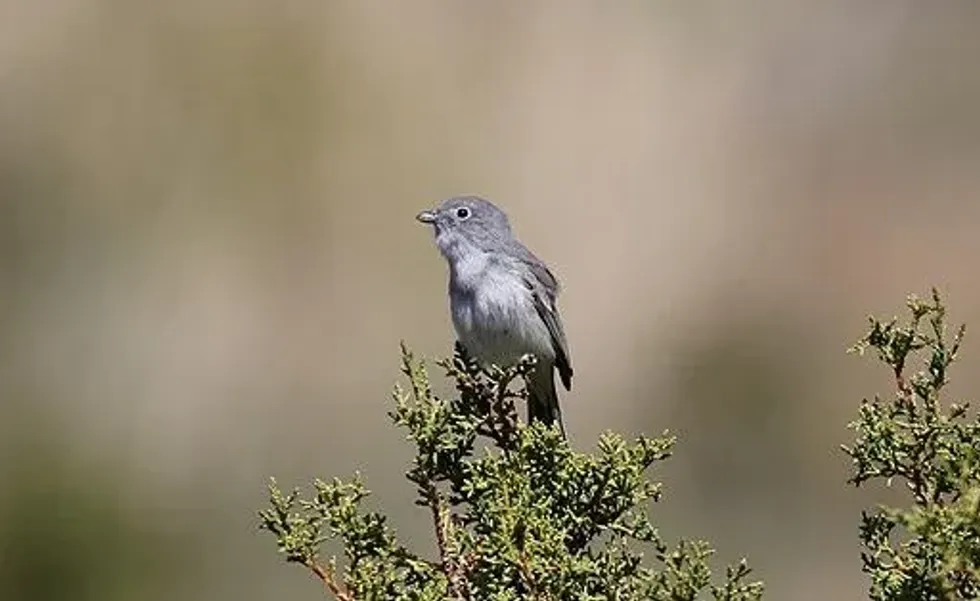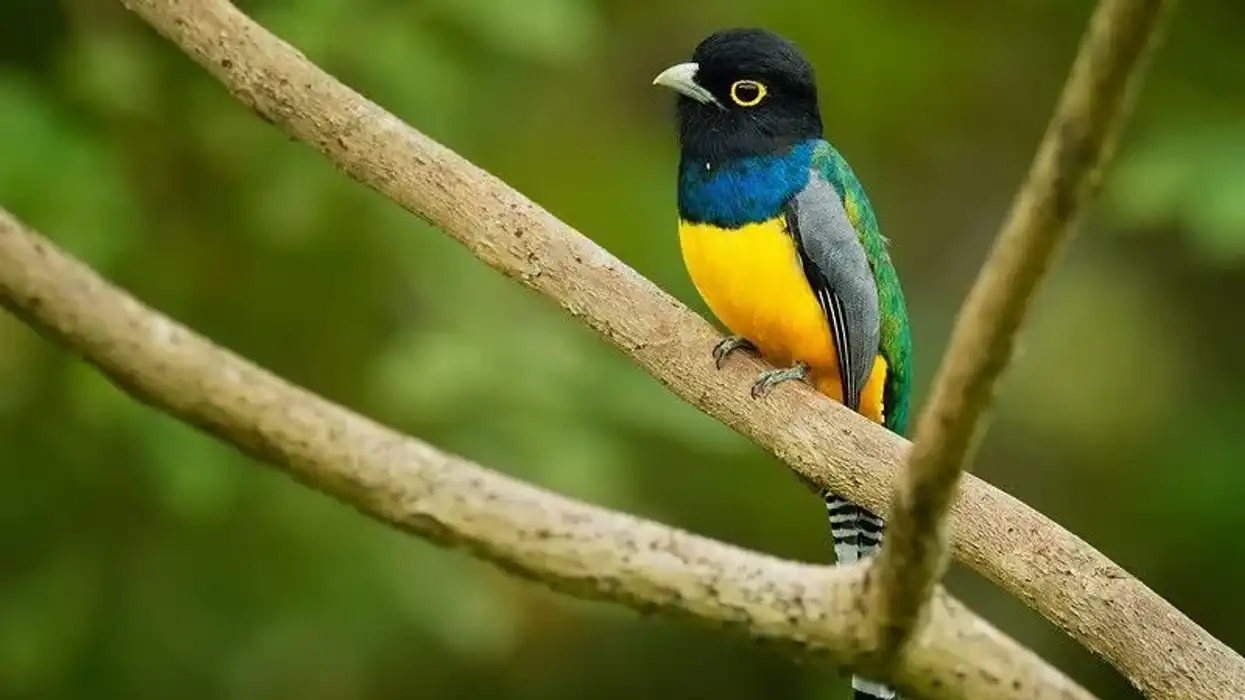Were you fascinated to learn about the black-capped vireos? If yes, then the tiny North American gray vireos (Vireo vicinior) will also excite you as both birds share a similar range.
The gray vireos belong to the order Passeriformes, family Vireonidae, and genus Vireo. This species is covered in gray and white plumage, which gives it a plain but cute look.
The location of these birds is based on the season, as during summers, you can find the breeding bird in the southwestern United States, southern California, northern Baja California, and western Texas. However, during wintering, the bird migrates to northwestern Mexico, southwestern Arizona, western Sonora state, and in southern Baja Peninsula in search of warm habitats.
These birds are fascinated with juniper bushes, and they will also nest in such areas. The species chooses to live in habitats such as dry bush, chaparral, arid mountains, and high plains that are relatively warmer.
You can often find the birds foraging on the ground for insects which is its primary food source. Even though the gray vireo birds have a small population, the range seems to be increasing, which is great.
Want to know more fun gray vireo facts? Then, keep on reading! Also, check out the articles on gray Kingbird and spotted flycatcher to know more about birds.
Gray Vireo Interesting Facts
What type of animal is a gray vireo?
The gray vireo is a small North American bird belonging to the order Passeriformes, family Vireonidae, and genus Vireo.
What class of animal does a gray vireo belong to?
As a bird species, the gray vireo belongs to the class Aves. This class also contains big birds like the hawks and even the tiniest hummingbirds.
How many gray vireos are there in the world?
The International Union for Conservation of Nature or the IUCN Red List states that the estimated population of this bird is 460,000 mature individuals. It also says that the bird's population is on the rise. About 90.2% growth has been seen in its population in the last three generations.
Where does a gray vireo live?
The gray vireo is one of the native birds of North America. These birds often keep on moving, and a breeding population is present in the southwestern United States, southern California, northern Baja California and it stretches to western Texas.
During wintering, these birds can be seen in northwestern Mexico, southwestern Arizona, western Sonora state, and in the southern Baja Peninsula. The only constant population can be found in southwest Texas's Big Bend National Park.
What is a gray vireo's habitat?
Gray vireos are mainly found in the subtropical zones, which are extensively found in California, Texas, as well as in Mexico. Scrub oak and pinyon-juniper is the preferential habitat for these small birds.
It can often be found moving around in the dry scrub, hunting for insects to eat. The bird can also use the scrub and juniper bushes as a place to form its nest.
The habitats might change according to the changing seasons. The breeding season for these birds is during the summer season when more time is spent in the dense vegetation.
Who do gray vireos live with?
Apart from the breeding season, gray vireos are mostly a solitary species, and the birds can be seen foraging for themselves. However, just before the wintering begins, the birds will form small flocks so that they can fly to places like Mexico to overwinter.
During the breeding season, the species can be agnostic to each other to protect their nest and territory.
How long does a gray vireo live?
The average lifespan of this species is around 4-5 years.
How do they reproduce?
This is a species that forms monogamous pairs during the breeding season. The breeding bird will actively seek out mates, and a mating call is used to woo the female. Males are the ones to seek out space to build the nest, and it is often made on juniper bushes.
The nests may also be made in thorny trees that are almost 3-6 ft (92-183 cm) above the ground. It takes 5-6 days to complete making the nest.
The female usually lays four eggs and incubates them in the nest for 13-14 days. This species makes cuplike nests. Both males and females will sit on the eggs until the hatching takes place.
What is their conservation status?
According to the International Union for Conservation of Nature (IUCN) Red List, the gray vireos (Vireo vicinior) currently have the conservation status of Least Concern.
Gray Vireo Fun Facts
What do gray vireos look like?

The gray vireo is a plain-looking small bird species that is covered in white and gray plumage. Its wings have gray feathers, while the belly is paler with gray splotches.
This tiny bird has a dark gray or black bill along with black eyes. It also has a white eye-ring that makes the irises pop. On the other hand, the feet have a bluish-gray color.
This species does have a long rounded tail with gray feathers on top and pale gray or white feathers on the bottom. The bird looks pretty similar to the bell's vireo.
How cute are they?
Most people find this bird species a little dull, but we do think that this tiny vireo looks just as adorable as the warbling vireo or the bell's vireo.
How do they communicate?
The gray vireo song can be pretty loud even though it comes from such a tiny bird. Different types of calls made by the Vireo vicinior include hu-wee, che-weet, chu-wee, chee, churr, ch-churr-weet, and schray. The fledged chicks make a zeep sound. In Texas, male birds will call till afternoon to woo the females and to establish its territory.
How big is a gray vireo?
The average size range of the grey vireo species is around 5.1-5.8 in (130–148 mm). The red-eyed vireo has an average size range of 4.7-5.1 in (120-130 mm), making the gray vireos slightly bigger.
How fast can a gray vireo fly?
Not much is known about the flying speed of the gray vireo species.
How much does a gray vireo weigh?
The average weight range of the gray vireo is around 0.4-0.48 oz (11.5–13.5 g).
What are the male and female names of the species?
There are no separate names for the male and female birds of this species.
What would you call a baby gray vireo?
A gray vireo baby is called a chick.
What do they eat?
The Vireo vicinior depends on fruits and insects as its main source of food. Its habitat will often decide the type of food it consumes, but these birds forage on the ground looking for food in most cases.
To make the search easy, the birds often scratch the surface of the ground with their feet. Insects like beetles, caterpillars, small moths, bugs, field crickets, treehoppers, dobsonflies, cicadas, and grasshoppers are mostly eaten during breeding.
In its wintering habitat in Mexico, the birds indulge in eating a lot of fruits. In addition, these birds like to feed on berries that grow on elephant trees.
Are they dangerous?
No, this bird is too tiny to be dangerous.
Would they make a good pet?
The grey vireo is a wild bird that has a low population. Hence, it wouldn't be a great idea to keep the species as a pet.
Did you know...
The brown-headed cowbird often parasites the nest of the gray vireo by leaving its eggs to be raised by the vireo family.
In Mexico, gray vireos are also known as vireo gris.
How do gray vireos act with humans?
No conclusive data is found about the interaction of the gray vireos with humans.
How are gray vireos affected by climate change?
Compared to other birds, the population status of gray vireos is supposed to flourish due to climate change without the need for conservation. As the bird already lives in warm areas, it may even take over the habitat of some other birds of North America.
For more relatable content, check out these gnatcatcher and giant Kingfisher facts for kids.
You can even occupy yourself at home by coloring in one of our free printable gray vireo coloring pages.









